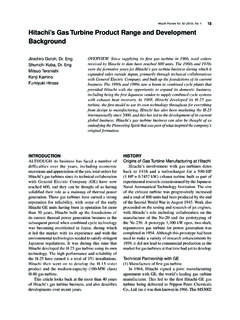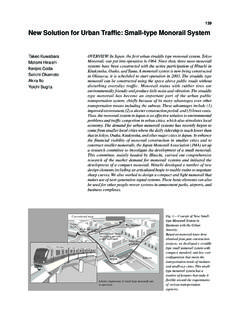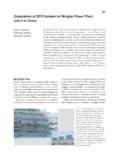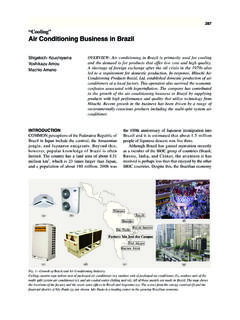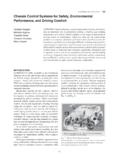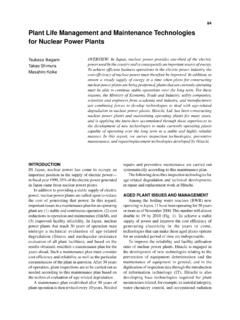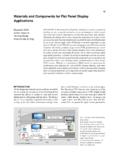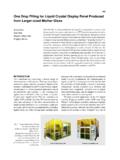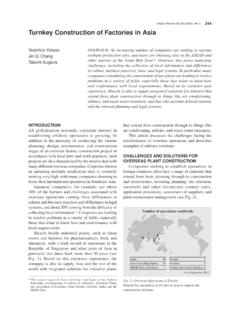Transcription of Development of Class 800/801 High-speed Rolling …
1 646 Hitachi Review Vol. 63 (2014), No. 10- 38 -Featured ArticlesDevelopment of Class 800/801 High-speed Rolling Stock for UK Intercity Express ProgrammeAndrew RogersChris RobinsonKoji AgatsumaMitsuo IwasakiSatoru Inarida, Dr. YamamotoKenta KonishiToshihiko MochidaOVERVIEW: Hitachi was formally awarded a Rolling stock manufacturing and maintenance contract for the UK IEP project in July 2012 through Agility Trains Ltd. Including additional orders, the contract covers the manufacture of a total of 866 cars and the provision of maintenance services for a period of years. With a total value of billion pounds, the IEP is the largest project in the history of British railways, and is intended to replace the aging Rolling stock on the UK s East Coast Main Line and Great Western Main Line, which run between London and other major cities in the UK.
2 The Class 800/801 Rolling stock for the IEP was developed based on the A-train concepts of lightweight aluminum carbodies and self-supporting interior modules by taking technologies developed in Japan to provide lighter weight and higher speed and applying them to UK railway systems. It will contribute to the provision of high -quality and reliable railway services, with commercial operation scheduled to commence in 2017, following operation trials in the UK that will start in developed the Class 800/801 Rolling stock for the Intercity Express Programme (IEP) to run between London and other major cities in the UK (see Fig. 1). The IEP project is intended to replace all of the Rolling stock on the UK s East Coast Main Line (ECML) and Great Western Main Line (GWML), that have been in service for more than 30 years(1).
3 The IEP is an initiative of the UK Department for Transport. It requires Hitachi to manufacture 866 High-speed cars and provide maintenance services for a period of years. Hitachi also plans to build a factory in the UK and manufacture the Rolling stock 1 Route Map for Class 800/801 High-speed Rolling Stock for UK on the A-train concept developed in Japan, Hitachi has developed High-speed Rolling stock for the UK IEP that runs services from London. The Rolling stock will contribute to high -quality and reliable railway services, with operational testing in the UK to commence in 2015, and commercial operation on the ECML and GWML (two major railway lines) in : Intercity Express Programme ECML: East Coast Main Line GWML: Great Western Main LineHitachi Review Vol. 63 (2014), No.
4 10 647 - 39 -This article provides an overview of the Class 800/801 High-speed Rolling stock for the UK IEP and describes the electrical system and the distinctive technologies it OF Class 800/801 ConceptThe Class 800/801 Rolling stock needs to comply with the latest European standards, including the Technical Specifications for Interoperability (TSI), and the Railway Group Standard (RGS) UK railway standards, and to have the flexibility to run on a number of different lines with different infrastructure (including non-electrified sections as well as aging platforms, bridges, and other features), and to adapt to future plans for electrification and variable passenger demand. Trains have a unit configuration of up to 12 cars, including the ability to add or remove standardized intermediate cars and the generator units (GUs) (generators with diesel engines) needed to operate commercial services on non-electrified lines.
5 Along with the A-train concept(2), (3) developed in Japan, the new Rolling stock is also based on technology from the Class 395 Rolling stock developed by Hitachi for the UK high speed 1 that entered commercial operation in 2009(4), (5), providing compatibility with UK railway systems together with high shape of the front-end cars features a One Motion Form (a Japanese expression meaning streamlined) design suitable for High-speed Rolling stock. And, in addition to environmental measures for reducing air resistance and noise, it features a collision safety structure that complies with the latest European standards. It also incorporates an automatic coupling system that shortens the time taken to couple or uncouple trains while stopped at a interior of the Rolling stock needs to comply with the Persons with Reduced Mobility-TSI (PRM-TSI) standard, maximize the seating capacity, and also be able to satisfy the requirements of different railway operating companies and future internal refurbishment.
6 Accordingly, the basic layout and carbody structure are standardized in accordance with the A-train concept of having a self-supporting interior module, and the specifications were determined at the design stage, which included review by UK railway operators, associated organizations, and third-party Specifi cationsFig. 2 shows the trainset layout and Table 1 lists the main specifications. Each trainset consists of either five or nine cars, with an automatic coupling device and cover (incorporating an opening and closing mechanism) fitted on the leading car. The 12-car maximum configuration for commercial operation is formed by linking two trainsets together and adding or removing standardized intermediate cars. Because the coupling or uncoupling of cars in a trainset occurs 25,3502535025,00025,0001,000 Universal access toiletBicycle storageUniversal access toiletKitchenBicycle storageStandard Class seatsFittingsDPTSU niversal access toilet561 Standard Class seatsFittingsMSSpace saver toilet882 Standard Class seatsFittingsMSBicycle storage881 Preparation room for on-board retail service1 First Class seatsFittingsMCStandard Class seats3038 Space saver toilet1 Bicycle storage1 First Class seatsFittingsDPTFU niversal access toilet151 Kitchen11,0001,000500 Units: mm50025,000 Fig.
7 2 Train Configuration (Five-car Trainset).Each trainset consists of five or nine cars, with an automatic coupling device with a cover (incorporating an opening and closing mechanism) fitted on the leading car and a 12-car maximum configuration for commercial operation formed by linking two trainsets together and adding or removing standardized intermediate : driving cab P: pantograph T: trailer car M: motor car S: standard Class C: composite (standard & first Class ) F: first class648 Development of Class 800/801 High-speed Rolling Stock for UK Intercity Express Programme- 40 -during commercial service at an intermediate station, the automatic coupling device is able to perform this operation in less than 2 3 shows photographs of the front end of a car, the driving cab, passenger compartments, a universal access toilet, and a bogie.
8 The carbodies are made of aluminum alloy with the sides, ceiling, and floor having a double-skin structure of hollow extrusions with a truss cross-section. The welding is performed using friction stir welding (FSW) to create light and strong carbodies with minimal distortion to the exterior. Also, because the trains operate at speeds of 200 km/h or more, the carbodies are air-tight to minimize interior pressure fluctuations and maintain the driving cab, the driver s seat is surrounded by the master controller together with a variety of switches and monitors. In addition to complying with the standards, the visibility and ease-of-use of the switches were assessed by drivers and human-factor experts and their feedback was incorporated into the passenger compartments are split into first Class and standard Class , with the seats, tables, and other fittings complying with RGS and PRM-TSI.
9 Along with collision safety and fire safety, the design and layout also take the needs of the disabled into account. The Rolling stock is designed to facilitate changes to the interior layout to accommodate changes to services or to the number of cars in the train. The vestibule has a large universal access toilet that incorporates the principles of universal design, and also has a storage area able to hold large items of luggage, including bicycles. A kitchen and preparation room are included to provide suitable catering services to passengers traveling long distances. Hitachi built a full-size mockup of these interior features to allow inspection by the railway operating companies, passenger organizations, railway unions, certification agencies, and other stakeholders.
10 This provided an opportunity to confirm the specifications and to identify and incorporate any design typeUK Class 800 (dual-mode train), Class 801 (electric train)Trainset5 cars (DPTS + MS + MS + MC + DPTF)9 cars (DPTS + MS + MS + TS + MS + TS + MC + MF + DPTF)No. of seats5-car configuration: 45 first Class , 270 standard class9-car configuration: 101 first Class , 526 standard classElectrical systemAC 25 kV, diesel engine-generatorGauge1,435 mmMax. operating speed201 km/h (max. design speed : 225 km/h) m/s2 DecelerationStandard: m/s2, Emergency: m/s2 Gradient1/37 = 27 Brake controlElectrically actuated pneumatic brakeMain converterIGBT converter/inverter + brake chopperMain motors226 kW continuousAuxiliary power supply 240 kVACarbodyAluminum double-skinBogiesBolster-lessAir conditioningHeater/cooler (internal ventilation fan)TABLE 1.
